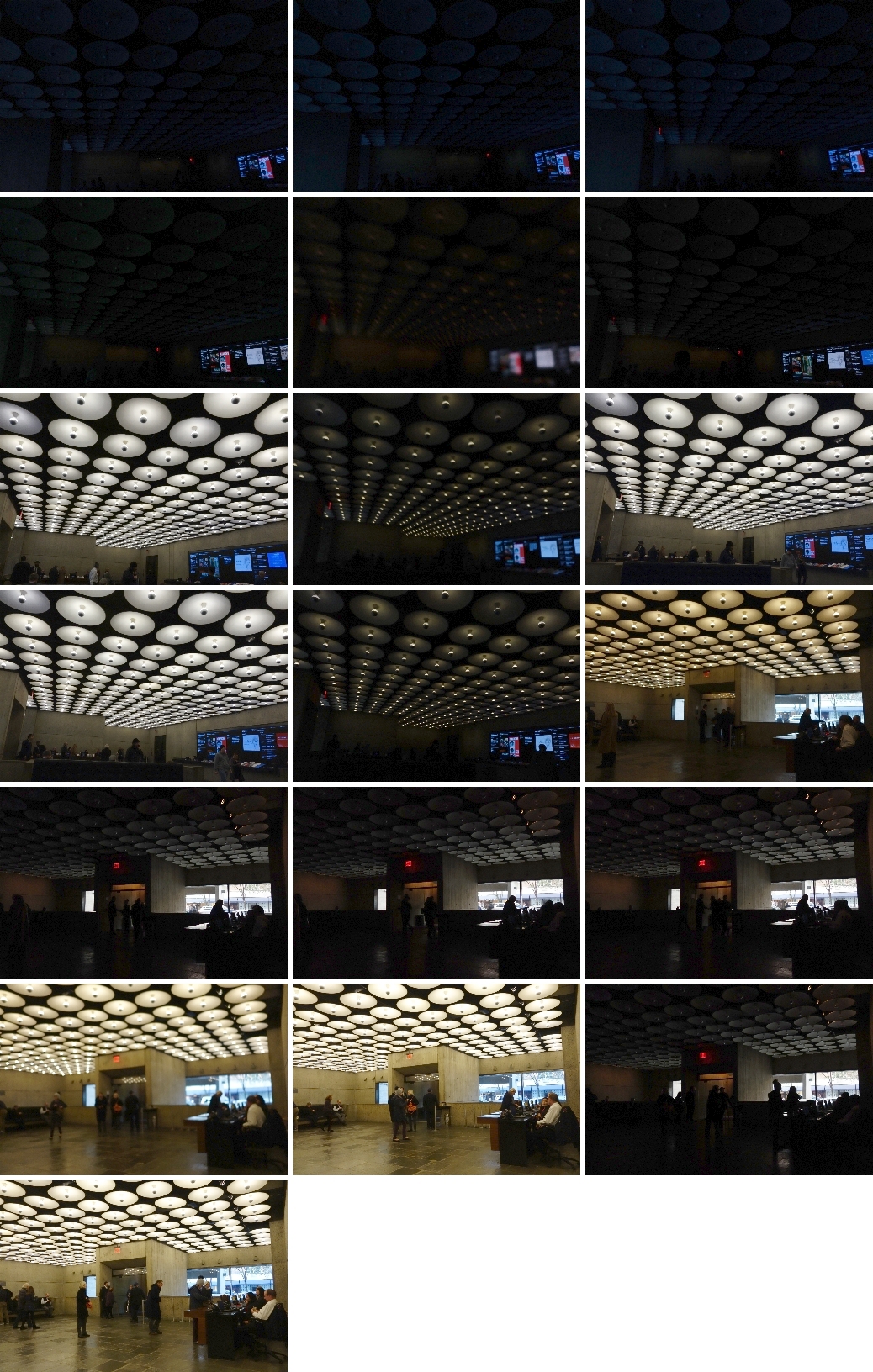
Reading the poem "The Pocket Mirror" by Janet Frame made me remember the interior design atrocity at the MET Breuer and its relationship to problems with LEDs that keep cropping up in microscopy and other high speed imaging fields. And, of course, in the new LED streetlamps replacing gas bulbs. Janet Frame was visionary regarding efficient lighting in the early 21st C. The first 1/3 of her poem succinctly describes a methodology for objectively measuring the phenomenon I'm complaining about:
The Pocket Mirror So many thousand times a minute the light from the street lamps goes out. I have devised a method by which this may be shown to those to whom the facts of light are unknown. Taking this pocket mirror, capture the reflection of the row of lamps. Steady the mirror. So. See those black stripes alternating with yellow? Those are the bars of actual darkness not perceived by the naked eye. To undeceive the sight a detached instrument like a mirror is necessary.
I'd like to know her method involving a pocket mirror! I used cameras to undeceive the naked eye.
The MET, which is supposed to be a museum that sets standards for world class museums, has a lobby with incredibly irritating lighting. (Based on visits from November 2017 to June 2018.)
The MET Breuer installed LEDs with a power supply that does not keep the DC power to the bulbs stable. Therefore, the LEDs blink at a high rate, 60 Hz. For people who can detect this, it is strobe lighting on steroids. When anything in my field of view moves, instead of a smooth movement, it is broken up into discrete steps; think of strobe lighting at a dance club, only much faster. When you are in the lobby, the entire room, from ticket counter to cloak room to elevators is a rapidly blinking chamber, every movement broken into discrete snapshots. Far more effective for drawing attention to the nature of light, surroundings, environment, ambience, than any California artist championed by Calvin Tomkins.
Nauseating. Literally nauseating.
Doesnít have to be like this. The power to the LEDs could be stable, thus no blinking. By using a camera to measure the blinking, it appears the LEDs are off for more of the time than they are on which, I suspect, makes the blinking appear even worse.
This is a series of photographs taken at random intervals with a high shutter speed (1/640 or 1/2000 sec). Some caught the LEDs on and some caught them off. Of the 19 pictures I took, 12 had the lights off.
At first glance, the ceiling lighting looks really nice. However, it is inferior and irritating; this should be fixed. The HomeDepo brand LED bulbs bought and plugged into normal sockets work fine; somehow, they got the AC conversion correct and the MET contractor couldn't do the same.
How soon will they make the mistake of bringing LEDs that donít have completely stable power supplies into exhibition areas?

The message for microscopy is that LEDs need to be stable or exposure times need to be long compared to the scale of the blinking, such as a minimum of 100 ms.
Back in 2010-12 we had two experiences with this.
One was my trying to replace a standard halogen bulb for transmitted light imaging on an Olympus scope with a LED. I replaced the halogen bulb in the Olympus lamp house with a LED ($1.69) and a resister (free, as there was a box of them in the lab already). Problem was we needed exposure times 1 to 10 ms. This was a failure. The AC to DC power supply was stable enough for a filament based bulb, but not for the LED. I kept getting blank images and at first I couldn't figure out why. Then I noticed that at longer exposures we got an image with every shot but the intensity varied. And at 100+ ms all the images looked the same.
The second was with a new "stable" high intensity LED we were sent on spec to try on a spinning disk confocal. With the standard lasers, the shortest exposure we could use with the confocal was 22 ms without seeing the microlens patterns (took 22 ms for the spinning disk to cover the entire field). But coupled with the LED, we got patterning. The intensity fluctuation was a hair over 1% in a sawtooth pattern. However, I was concerned it could be the camera, so as a controls I imaged a desk lamp with a fluorescent bulb (60 Hz, curve not shown) and a battery operated flashlight which decayed steadily because the battery was dying, the the point is that the curve is smooth.

We told the LED company and they immediately fixed the problem with the power supplies so they have a truly stable product.
Other pictures of the LED power supply issue:
Examples of 60Hz blinking with cheap Christmas lights: https://www.flickr.com/photos/mcammer/8368726528/ https://www.flickr.com/photos/mcammer/8304681708/ Here you can compare filament bulbs with LEDs on the same Christmas tree: https://www.flickr.com/photos/mcammer/8336450548/ Appliances in a kitchen. They have LEDs with cheap AC to DC converters: https://www.flickr.com/photos/mcammer/28926097140/ Saw this on a Broadway stage too. "The Band's Visit" (seen July 22) has a night light over a crib which irritatingly blinks and, based on the chronology of the play, is probably anachronistic. And an example with a high intensity LED flashing on falling sleet in a hotel parking lot, but sleet itself may be oscillating: https://www.flickr.com/photos/mcammer/8341108426/
Ok, maybe I misrepresented Frame's literal reference to the science of light. I doubt 50 or 60 Hz electricity supply was her source material. More likely, she knew about light having a discrete wavelength which, with a pocket mirror, might be able to create interference patterns such as the stripes on these ice crystals.
(If you want to read the last 2/3 of the poem, you'll have to go to a library or go buy the book.)